
Atrophaneura Hector, the crimson rose, is a large swallowtail butterfly belonging to the genus Pachliopta (roses) of the red-bodied swallowtails. It is recorded as a species of "Least Concern (LC)" by IUCN.

Pachliopta aristolochiae, the common rose, is a species of swallowtail butterfly belonging to the genus Pachliopta, the roses, or red-bodied swallowtails. It is a common butterfly which is extensively distributed across south and southeast Asia.

Byasa dasarada, the great windmill, is a butterfly found in India that belongs to the windmills genus, Byasa, comprising tailed black swallowtail butterflies with white spots and red submarginal crescents.
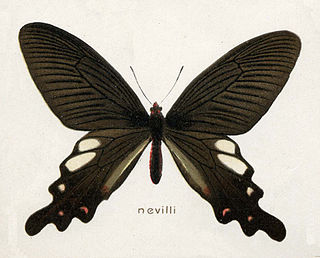
Byasa nevilli, the Nevill's windmill, is a butterfly found in India that belongs to the windmills genus (Byasa), comprising tailed black swallowtail butterflies with white spots and red submarginal crescents.
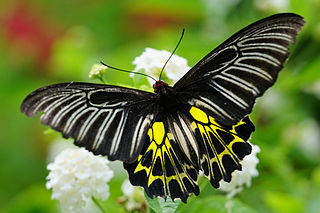
Troides aeacus, the golden birdwing, is a large tropical butterfly belonging to the swallowtail family, Papilionidae.

Troides helena, the common birdwing, is a butterfly belonging to the family Papilionidae. It is often found in the wildlife trade due to its popularity with butterfly collectors. The butterfly has seventeen subspecies.

Losaria coon, the common clubtail, is a butterfly belonging to the swallowtail family, Papilionidae. The butterfly belongs to the clubtails, genus Losaria. It includes several subspecies and is found from the Nicobar Islands and Assam in India, east to Hainan in China, and south through Indochina, to Java and other islands of Indonesia and Bangladesh.

Papilio (Chilasa) agestor, the tawny mime, is a swallowtail butterfly, native to Indian subcontinent and widely found across Asia. The butterfly belongs to the mime subgenus, Chilasa, of the genus Papilio or the black-bodied swallowtails.

Papilio (Chilasa) slateri, the blue striped mime, is a swallowtail butterfly found across south and south-east Asia. The butterfly belongs to the mime subgenus, Chilasa, of the genus Papilio, the black-bodied swallowtails. The nominate subspecies is found in India and is also called the brown mime. It is a good example of mimicry among Indian butterflies.

Byasa latreillei, the rose windmill, is a butterfly from the windmills genus (Byasa), found in various parts of Asia, comprising tailed black swallowtail butterflies with white spots and red submarginal crescents.

Atrophaneura aidoneus, the lesser batwing, is an Asian species of butterfly that belongs to the batwings group of Atrophaneura, comprising tailless black swallowtail butterflies.
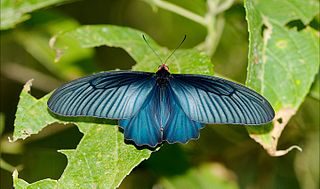
Atrophaneura varuna, the common batwing, is a butterfly found in India and Southeast Asia that belongs to the swallowtail family, and more specifically, the batwings group of Atrophaneura, comprising tailless black swallowtail butterflies.
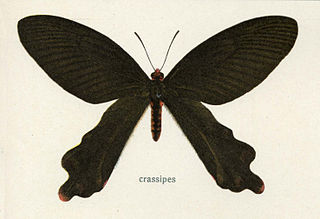
Byasa crassipes, the black windmill, is a butterfly found in India and Southeast Asia that belongs to the windmills genus, Byasa, comprising tailed black swallowtail butterflies with white spots and red submarginal crescents.
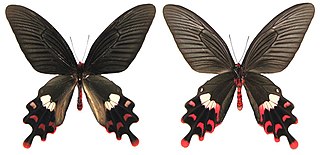
Byasa polla, the De Nicéville's windmill, is a butterfly found in India that belongs to the windmills genus (Byasa), comprising tailed black swallowtail butterflies with white spots and red submarginal crescents.

Byasa plutonius, the Chinese windmill, is a butterfly found in Asia that belongs to the windmills genus (Byasa), comprising tailed black swallowtail butterflies with white spots and red submarginal crescents.

Parnassius staudingeri hunza, the Karakoram banded Apollo, is a high-altitude butterfly which is found in India. It is a member of the genus Parnassius of the swallowtail family, Papilionidae. It was variously treated as a subspecies of P. delphius and a distinct species. The subspecies was first described by Grigory Grum-Grshimailo in 1888.

Red-bodied swallowtails, or ruby swallowtail (due to the color), are butterflies in the swallowtail family, that belong to the genera Atrophaneura, Byasa, Losaria, or Pachliopta. They are generally found in Asia.

Byasa alcinous, the Chinese windmill, is a butterfly of the family Papilionidae.

Byasa impediens, the pink-spotted windmill, is a species of butterfly from the family Papilionidae (swallowtails) found in Taiwan.






















